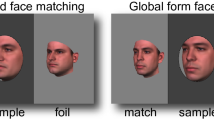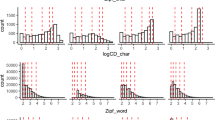Abstract
Thirty children in Geneva, Switzerland, 15 middle-class children in Bariloche and 15 lower-class children from a semi-literate or illiterate milieu in Bariloche, Argentina, were tested. All children were aged 6 and attending public schools. Tasks were: (1) judging which of two bi- or tri-digit written numerals was the biggest, and explaining why; and (2) explaining the role played by the different digits in numerals such as 11, 12, 16, 17. Results show that children at these ages use various strategies in task 1: they compare number of digits; read aloud the numerals and refer to number-string knowledge; treat bi- and tri-digits as the sum of their face value parts; and lastly, quite often take both face value and position of digits into account in a correct way. They, however, were not able to explain place-value. Most subjects gave “face value interpretations”, while a few children account for the whole collection of chips and make part of the chips correspond to one digit, and the other part to the other digit. Differences in performance between the three types of children emerge.
Similar content being viewed by others
References
Allardice, B.: 1977, ‘The development of written presentation for some mathematical concepts’,Journal of Children's Mathematical Behavior 1(4), 135–148.
Bassedas, M. and Sellarès, R.: 1982, ‘La construcción individual del sistema de numeración convencional’,Infancia y Apprendizage 19–20, 75–88.
Bednarz, N. and Dufour-Janvier, B.: 1986, ‘Une étude des conceptions inappropriées developpées par les enfants dans l'apprentissage de la numération au primaire’,Journal Européen de Psychologie de l'Education,1–2, 17–33.
Bednarz, N. and Janvier, B.: 1982, ‘The understanding of numeration in primary school’,Educational Studies in Mathematics,13, 33–57.
Bednarz, N. and Janvier, B.: 1984a, ‘La numération: Les difficultés suscitées par son apprentissage’,N,33, 5–31.
Bednarz, N. and Janvier, B.: 1984b, ‘La numération: Une stratégie didactique cherchant à favoriser une meilleure compréhension’,N,34, 5–17.
Bednarz, N. and Janvier, B.: 1988, ‘A constructivist approach to numeration in primary school: Results of a three year intervention with the same group of children’,Educational Studies in Mathematics 19, 299–331.
Bergeron, A., Herscovics, N., and Bergeron, J. C.: 1987a, ‘Kindergartners' knowledge of numbers: A longitudinal case study, Part I: Intuitive and procedural understanding’, in J. C. Bergeron, N. Herscovics, and C. Kieran (eds.),Proceedings of the 11th Psychology of Mathematics Education Conference, Vol. II, Montreal.
Bergeron, A., Herscovics, N., and Bergeron, J. C.: 1987b, ‘Kindergartners' knowledge of numbers: A longitudinal case study, Part II: Abstraction and formalization’, in J. C. Bergeron, N. Herscovics, and C. Kieran (eds.),Proceedings of the 11th Psychology of Mathematics Education Conference, Vol. II, Montreal.
Bergeron, J. C. and Herscovics, N.: 1990, ‘The kindergartners' knowledge of numerals’, in G. Booker, P. Cobb, and T. N. de Mendicuti (eds.),Proceedings of the 14th PME Conference, Mexico.
Brun, J., Giossi, J. M., and Henriques, A.: 1984, ‘A propos de l'écriture décimale’,Math-Ecole 23(112), 2–11.
Denvir, B. and Brown, M.: 1986a, ‘Understanding of number concepts in low attaining 7–9 year olds: Part I. Development of descriptive framework and diagnostic instrument’,Educational Studies in Mathematics 17, 15–36.
Denvir, B. and Brown, M.: 1986b, ‘Understanding of number concepts in low attaining 7–9 year olds: Part II. The teaching studies’,Educational Studies in Mathematics 17, 143–164.
Fuson, K. C.: 1990, ‘Issues in place value and multidigit addition and subtraction learning and teaching’,Journal for Research in Mathematics Education 21 (4), 273–280.
Grau I Franch, X.: 1988, ‘La serie numérica: reconstruir para generalizar’, in M. Moreno (ed.),Ciencia, aprendizage y communicación, Editorial Laia, Barcelona.
Hiebert, J.: 1988, ‘A theory of developing competence with written mathematical symbols’,Educational Studies in Mathematics 19, 333–355.
Hughes, M.: 1986,Children and Numbers. Difficulties in Learning Mathematics, Basil Blackwell, Oxford.
Janvier, C. (ed.): 1987,Problems of Representation in the Teaching and Learning of Mathematics, Lawrence Erlbaum, Hillsdale, NJ.
Kamii, M.: 1982, ‘Children's Graphic Representation of Numerical Concepts: A Developmental Study’, Unpublished doctoral dissertation, Harvard University.
Kamii, M.: 1980, ‘Place Value: Children's Efforts to Find a Correspondence Between Digit and Number of Objects’, paper presented at the Tenth Annual Symposium of the Jean Piaget Society, Philadelphia, PA, May.
Kamii, C.: 1986, ‘Place value: An explanation of its difficulty and educational implications for the primary grades’,Journal of Research in Childhood Education 1 (2), 75–85.
Kamii, C. and De Clark, G.: 1985,Young Children Reinvent Arithmetic, Teachers College Press, New York.
Kamii, C. and Joseph, L.: 1988, ‘Teaching place value and double column addition’,Early Childhood Mathematics 35, 48–52.
Perret, J. F.: 1987, ‘Quelle psychologie pour quel apprentissage des math ématiques?’,European Journal of Psychology of Education 11(3), 247–260.
Resnick, L. B.: 1983, ‘A development theory of number understanding’, in H. P. Ginsburg (ed.),The Development of Mathematical Thinking, Academic Press, New York, pp. 109–151.
Richards, J. and Carter, R.: 1982, ‘The Numeration System’, paper presented at the AREA Symposium, New York, March.
Ross, S. H.: 1986, ‘The Development of Children's Place Value Numeration Concepts in Grades 2 Through 5’, paper presented at the Annual Meeting of the American Education Research Association, San Francisco, April.
Ross, S. H.: 1988, ‘The Role of Cognitive Development and Instruction in Children's Acquisition of Place Value Numeration Concepts’, paper presented at the Annual Meeting of the National Council of Teachers of Mathematics, Chicago, April.
Sastre, G. and Moreno, M.: 1976, ‘Représentation graphique de la quantité’,Bulletin de Psychologie de l'Université de Paris 30, 346–356.
Sinclair, A.: 1988, ‘La notation numérique chez l'enfant’, in H. Sinclair (ed.),La Production de Notations Chez le Jeune Enfant, Presses Universitaires de France, Paris.
Author information
Authors and Affiliations
Rights and permissions
About this article
Cite this article
Sinclair, A., Scheuer, N. Understanding the written number system: 6 Year-olds in Argentina and Switzerland. Educ Stud Math 24, 199–221 (1993). https://doi.org/10.1007/BF01273692
Issue Date:
DOI: https://doi.org/10.1007/BF01273692




